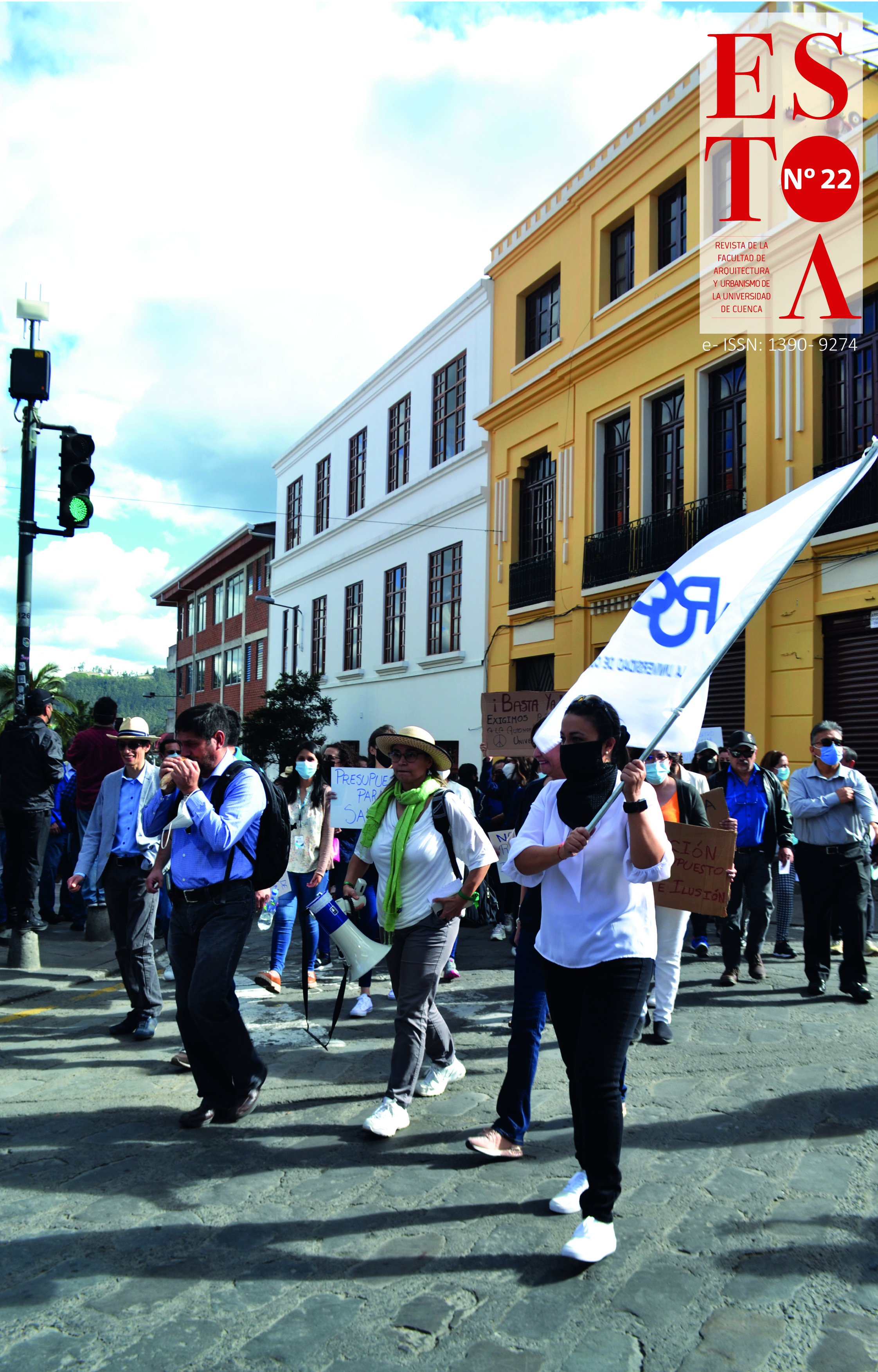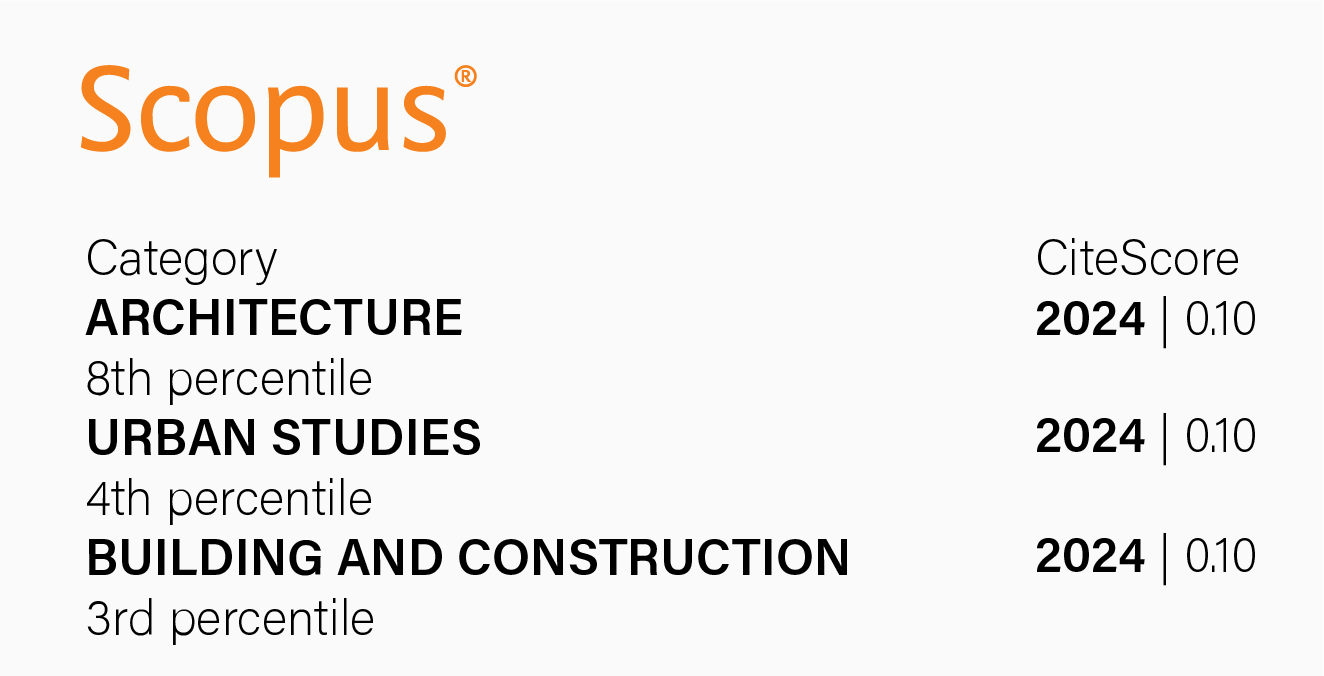Intervention on the Leaning Tower bell of Pisa: Between integrations and disengagement
DOI:
https://doi.org/10.18537/est.v011.n022.a11Keywords:
tower, architecture, conservation, heritage, monumentsAbstract
There are numerous technical solutions to intervention of heritage buildings that are useful to avoid or reduce degradation. Although these solutions have satisfactory experiences, they are not a guarantee to generalize them. To explain this curious fact, this study of the interventions was carried out in the course of history in the Bell Tower of the Cathedral of Pisa. This emblematic building has experienced differential settlements since its construction, generating its inclination for what is internationally known. During course of its existence, it has been a scenario of different types of interventions, mostly integrations and releases. A systematic review is presented on the different and most representative intervention actions, to know how these have influenced the variation of its state of degradation. Not all actions implemented were successful. Controlled on-site experimentation, with scale models, has so far been the safest way to intervention.
Downloads
References
Aguilera Jiménez, P. (2013). Catedral de México: Hundimiento y rescate. Instituto de Ingeniería de la Universidad Autónoma de la Ciudad de México. http://www.iingen.unam.mx/es-mx/Publicaciones/Libros/Documents/LibroCatedral.pdf
Ascani, V. (2014). The Leaning Tower of Pisa. Concept and Realisation of a Medieval Masterpiece. Edizioni ETS.
Atkinson, M. F. (2003). Structural foundation manual for low-rise building. Spon press.
Bahamón, A., y Álvarez, A. M. (2009). Palafitos: de arquitectura vernácula a contemporánea. Parramón
Bajaj, R., y Choudhary, S. (2014). Outstanding Structure: The Leaning Tower of Pisa. Journal of Civil Engineering and Environmental Technology, 1(5), 80-83. http://www.krishisanskriti.org/jceet.html
Broto, C. (2006). Enciclopedia Broto de patologías de la construcción. Gustavo Gili.
Burland, J. B. (2008). Stabilising the Leaning Tower of Pisa: The Evolution of Geotechnical Solutions. Transactions of the Newcomen Society, 78(2), 175-205. http://dx.doi.org/10.1179/175035208X317657
Burland, J. B. (2014). The Stabilization of the Leaning Tower of Pisa. Journal of Architectural Conservation, 8(3), 7-23. https://doi.org/10.1080/13556207.2002.10785324
Burland, J. B., Jamiolowki, M., y Viggiani, C. (2003). The stabilisation of the leaning tower of Pisa. Soils and Foundations, 43(5), 63-80. https://doi.org/10.3208/sandf.43.5_63
Calabresi, G., y Carlo, C. G. (1991). Le attuali condizioni di stabilità della Torre di Pisa. Materiali e strutture, 1, 3-11.
Caldelli, V., y Meucci, G. (2005/2010). La Torre Pendente. il restauro del secolo. Pacini Editore.
Castex, J. (2008). Architecture of Italy. Greenwood Press.
Coldstream, N. (1991). Mason and Sculptors. University of Toronto Press.
Coldstream, N. (2002). Medieval Architecture. Oxford University Press.
Costa, A., Miranda Guedes, J. y Varum, H (Eds.). (2014). Structural Rehabilitation of Old Buildings. Springer. https://doi.org/10.1007/978-3-642-39686-1
Costa, A., Arêde, A. y Varum, H. (Eds.). (2018). Case Studies of Building Pathology in Cultural Heritage. Springer. https://doi.org/10.1007/978-981-10-5858-5
Croce, P. (2021). New frontiers of Composites Applications in Heritage Building: Repair of exposed Masonry of St. Nicola Church in Pisa. Journal of Composites Science, 5(218). https://doi.org/10.3390/jcs5080218
Croci, G. (2001). Las torres y su asentamiento: Los casos de la torre de pisa y las torres de Angkor. Loggia (11), 86-96. https://doi.org/10.4995/loggia.2001.5233
Croci, G. (2012). Conservazione e restauro strutturale dei beni architettonici. CittàStudi.
D'Altri, A.M., Milani, G., de Miranda, S., Castellazzi, G., y Sarhosis, V. (2018). Stability analysis of leaning historic masonry structures. Automation in Construction, 92, 199-213. https://doi.org/10.1016/j.autcon.2018.04.003
Das, B. M. (1999). Shallow Foundations: Bearing Capacity and Settlement. CRC PRESS.
Delgado, J.M.P.Q (Ed.). (2016). New Approaches to Building Pathology and Durability. Springer. https://doi.org/10.1007/978-981-10-0648-7
Delgado, J.M.P.Q (Ed.). (2021). Case Studies in Building Rehabilitation. Springer. https://doi.org/10.1007/978-3-030-49202-1
Delgado, J.M.P.Q (Ed.). (2022). Masonry: Building Pathologies and Design. Springer. https://doi.org/10.1007/978-3-030-80496-1_1
Federal Emergency Management Agency [FEMA]. (2006). Techniques for the Seismic Rehabilitation of existing building. Federal Emergency Management Agency (FEMA).
Feilden, B. M. (1982/2003). Multi-disciplinary collaboration project in the UK. En Conservation of Historic Building (pp. 189-202). Architectural Press.
Fletcher, B. (1905/1996). A History of Architecture on the Comparative Method. Bradbury Agnew & Co. Ld.
Fiorentino, G., Nuti, C., Squeglia, N., Lavorato, D., y Stacul, S. (2018). One-Dimensional Nonlinear Seismic Response Analysis Using Strength-Controlled Constitutive Models: The Case of the Leaning Tower of Pisa’s Subsoil. Geosciences, 8(7). https://doi.org/10.3390/geosciences8070228
Geng, J., Meng, Z.P., Yin, B.X., y Zhu, L.F. (2020) Simulation on Sequential Construction Process and Structure of the Pisa Tower. Journal of Building Construction and Planning Research, 8, 30-41. https://doi.org/10.4236/jbcprt.2020.81003
Hamma-Adama, M., Iheukwumere, O., y Kouider, T. (2020). Analysis of Causes of Building Collapse: System Thinking
Approach. Jordan Journal of Civil engineering, 14(02), 188-197. https://jjce.just.edu.jo/issues/paper.php?p=4936.pdf
Heyman, J. (1997). The Stone of Skeleton: Structural Engineering of Masonry Architecture. Cambridge University Press. https://doi.org/10.1017/CBO9781107050310
Heyman, J. (1995/1999). Teoría, historia y restauración de estructuras de fábrica. Instituto Juan de Herrera.
International Council of Monuments and Sites. (1964). Carta de Venecia. UNESCO.
Jamiolkowski, M., Lancellotta, R., y Pepe, C. (1993). Leaning Tower of Pisa: Updated Information. Proceeding: Third International Conference on Case Histories in Geotechnical Engineering (pp. 1319-1330). Missouri University of Science and Technology. https://scholarsmine.mst.edu/icchge/3icchge/3icchge-session15/5
Jamiolkowski, M., y Viggiani, C. (2007). The restoration of the Leaning Tower of Pisa. Pacini Editore.
Karimi, Z., Dashti, S., Bullock, Z., Porter, K., y Liel, A. (2018). Key predictors of structure settlement on liquefiable ground: A numerical parametric study. Soil Dynamics and Earthquake Engineering, 113, 286-308. https://doi.org/10.1016/j.soildyn.2018.03.001
Kouris, E. G., Kouris, L. A. S., Konstantinidis, A. A., Karayannis, C. G., y Aifantis, E. C. (2021). Assessment and fragility of Byzantine unreinforced masonry towers. Infrastructures, 6(3), 40. https://doi.org/10.3390/infrastructures6030040
Lodigiani, A., y Macchi, G. (2005). Technologies for the prestressing rings of the Leaning Tower of Pisa. Structural Analysis of Historical Constructions (pp. 771-779). Taylor & Francis Group.
Mainstone, R. (1983/2001). Support, walls and foundations. En R. Mainstone, Development in Structural Form (pp. 175-191). Routledge.
Marchi, M. (2008). Stability and strength analysis of leaning towers [Disertación doctoral, University of Padova]. https://www.repository.unipr.it/bitstream/1889/958/1/MarchiM_PhDThesis.pdf
Mark, R. (1993/2002). Tecnología arquitectónica hasta la revolución científica. Arte estructura de las grandes construcciones. Akal.
Michiels, T. L. (2015). Seismic Retrofitting Techniques for Historic Adobe Buildings. International Journal of Architectural Heritage, 9(8), 1059-1068. https://doi.org/10.1080/15583058.2014.924604
Naghibi, F. y Fenton, G. A. (2021). Design of foundations against differential settlement. Canadian Geotechnical Journal, e-Firest, 1-13. https://doi.org/10.1139/cgj-2020-0782
Namdar, A., Dong, Y., y Deyu, Y. (2019). The Effect of Concrete Footing Shape in Differential Settlement: A Seismic Design. Advances in Civil Engineering. https://doi.org/10.1155/2019/9747896
Olanrewaju, A., Han Tee, S., Im Lim, P., y Fang Wong, W. (2022). Defect management of hospital buildings. Journal of Building Pathology and Rehabilitation, 7(18). https://doi.org/10.1007/s41024-021-00159-6
Ronzani, M., y Ascani, V. (2011). La torre pendente. Storia e interpretazione del campanile del Duomo di Pisa (Mirabilia pisana). Edizione ETS.
Sánchez Lavín, J. R., Escolano Sánchez, F. y Mazariegos de la Serna, A. (2018). Chemical Injections realized with null pressure for underpinning the foundation of an 18th century building located in the historical city of Cuenca (Spain). Applied Sciences, 8 (7). https://doi.org/10.3390/app8071117
Santollo Villa, E., y Ovando Shelley, E. (2008). Catedral y Sagrario de la Ciudad de México. TGC Geotécnia.
Simons, N., y Menzies, B. (1975/2001). A short course in foundation engineering. Thomas Telford.
Solà-Morales, I. (2006). Intervenciones. Gustavo Gili.
Squeglia, N., y Bentivoglio, G. (2014). Role of Monitoring in Historical Building Restoration: The Case of Leaning Tower of Pisa. International Journal of Architectural Heritage, 9(1), 338-347. http://dx.doi.org/10.1080/15583058.2013.865813
Terracina, F. (1961). La torre de Pisa. Le vicende del terreno sottostante e una via per stabilizzare il monumento. L´ingegnere.
Terracina, F. (1962). Foundations of the tower of Pisa. Géotechnique, 12(4), 336-339. https://doi.org/10.1680/geot.1962.12.4.336
UNESCO. (1964). International Charter for the conservation and restoration of monuments and sites. https://www.icomos.org/charters/venice_e.pdf
UNESCO. (2021). Piazza del Duomo, Pisa. https://whc.unesco.org/en/list/395/
Watt, D. (1999/2007). Building pathology. Principles and practice. Blackwell Publishing.
Wu, Y., Gao, Y., Zhang, L. y Jun Yang, J. (2019). How distribution characteristics of a soil property affect probabilistic foundation settlement — from the aspect of the first four statistical moments. Canadian Geotechnical Journal, 57(4), 595 - 607. https://doi.org/10.1139/cgj-2019-0089
Ziolkowsky, A. (2006). What did Agrippa's Pantheon Look like? New Answers to an Old Question. En G. Graßhoff, M. Heinzelmann, y M. Wäfler (Ed.), The Pantheon in Rome: contributions to the conference, Bern, (pp. 29-39). Universität Bern, Wissenschaftstheorie und Wissenschaftsgeschichte.
Published
How to Cite
Issue
Section
License
Copyright (c) 2022 Estoa. Revista de la Facultad de Arquitectura y Urbanismo

This work is licensed under a Creative Commons Attribution-NonCommercial-ShareAlike 4.0 International License.
The Journal declines any responsibility for possible conflicts derived from the authorship of the works that are published in it.
The University of Cuenca in Ecuador conserves the patrimonial rights (copyright) of the published works and will favor the reuse of the same ones, these can be: copy, use, diffuse, transmit and expose publicly.
Unless otherwise indicated, all contents of the electronic edition are distributed under a Creative Commons Attribution-NonCommercial-ShareAlike 4.0 International License.




